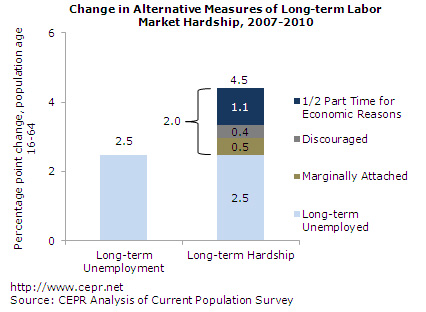January 05, 2012
As states get ready for cuts to the federal Extended Benefits program, those who have been unemployed the longest get ready for their struggle to become even more difficult. Our most recent recession has caused an unprecedented increase in the number of people unemployed for at least six months. In our new paper, John Schmitt and I make the case for two significant changes to our thinking on long-term unemployment.
First, we suggest expanding the current discussion on long-term unemployment to include all workers facing “long-term hardship” in the labor market. This broader category would include “discouraged,” “marginally attached” and involuntary part-time workers. While these workers are not included in the long-term unemployment rate, they have faced a good deal of long-term hardship in recent years due to the weak labor market. The figure below shows that the number of people facing long-term hardship, by this expanded definition, is more than double the amount of long-term unemployed.

Second, we suggest adding an alternative to the standard measure of long-term unemployment, which calculates the share of the unemployed who have been out of work for 27 weeks or more. The alternative measure would express those same individuals as a share of the total labor force. As we show in our paper, this alternative measure has several features to complement the standard long-term unemployment rate.






